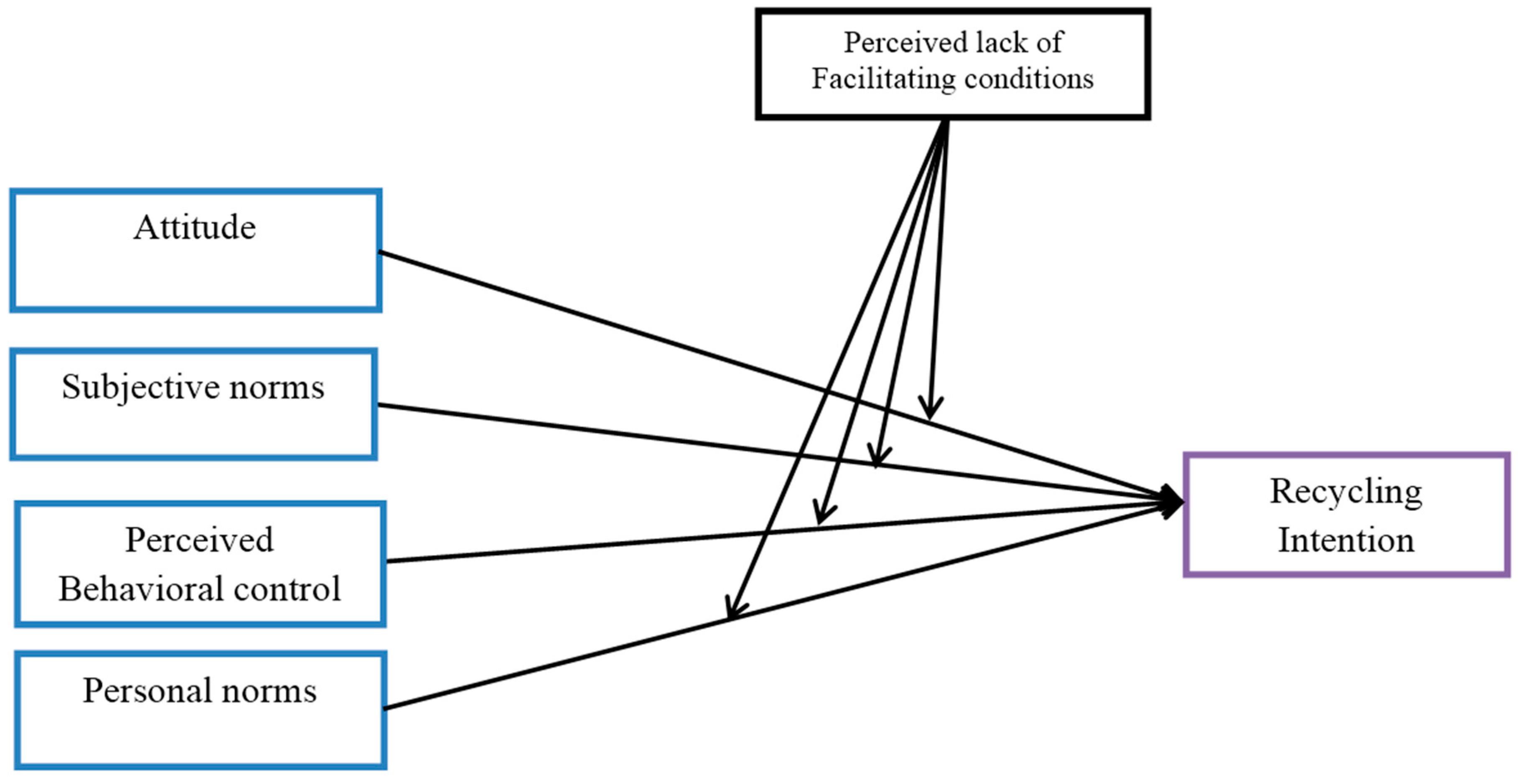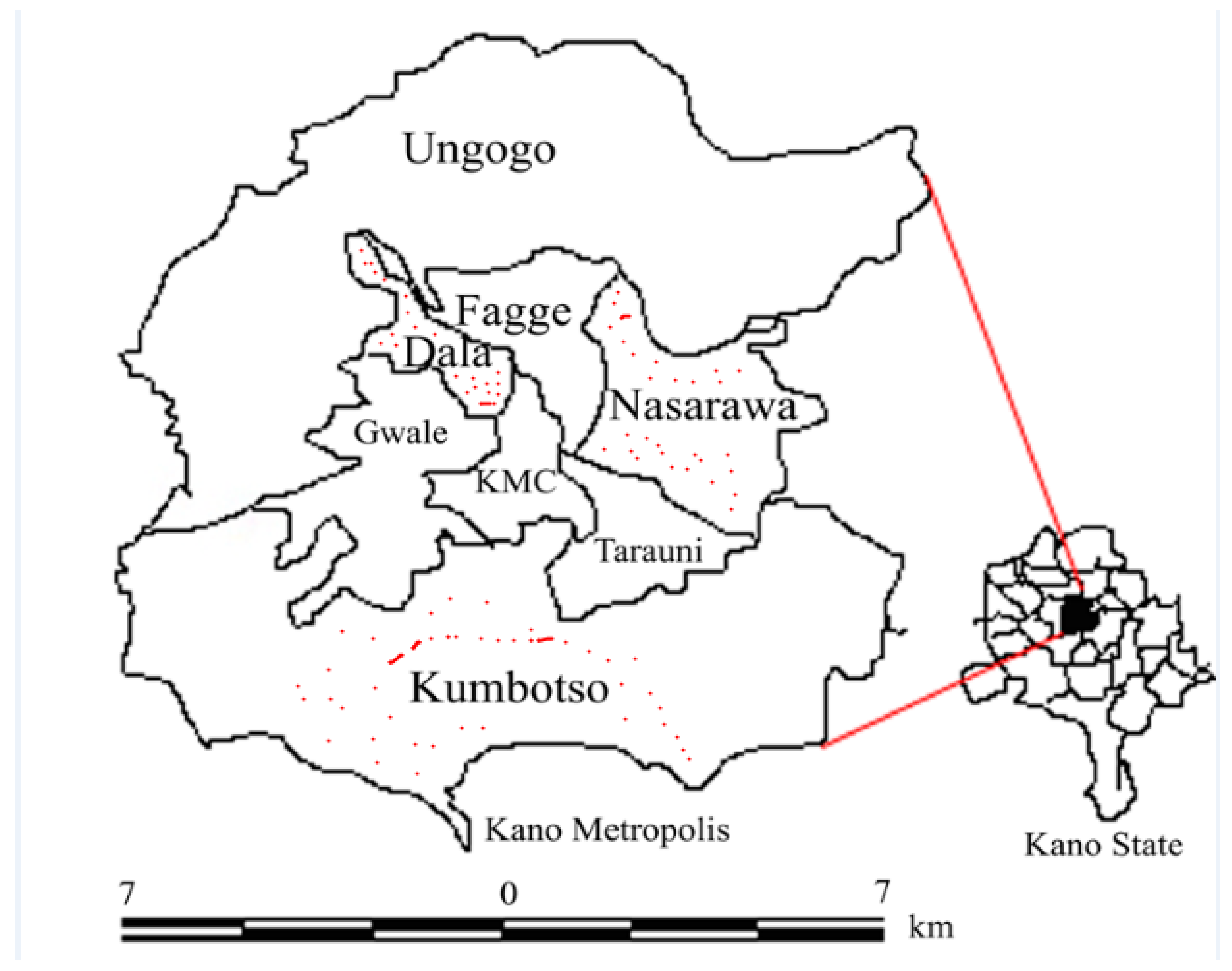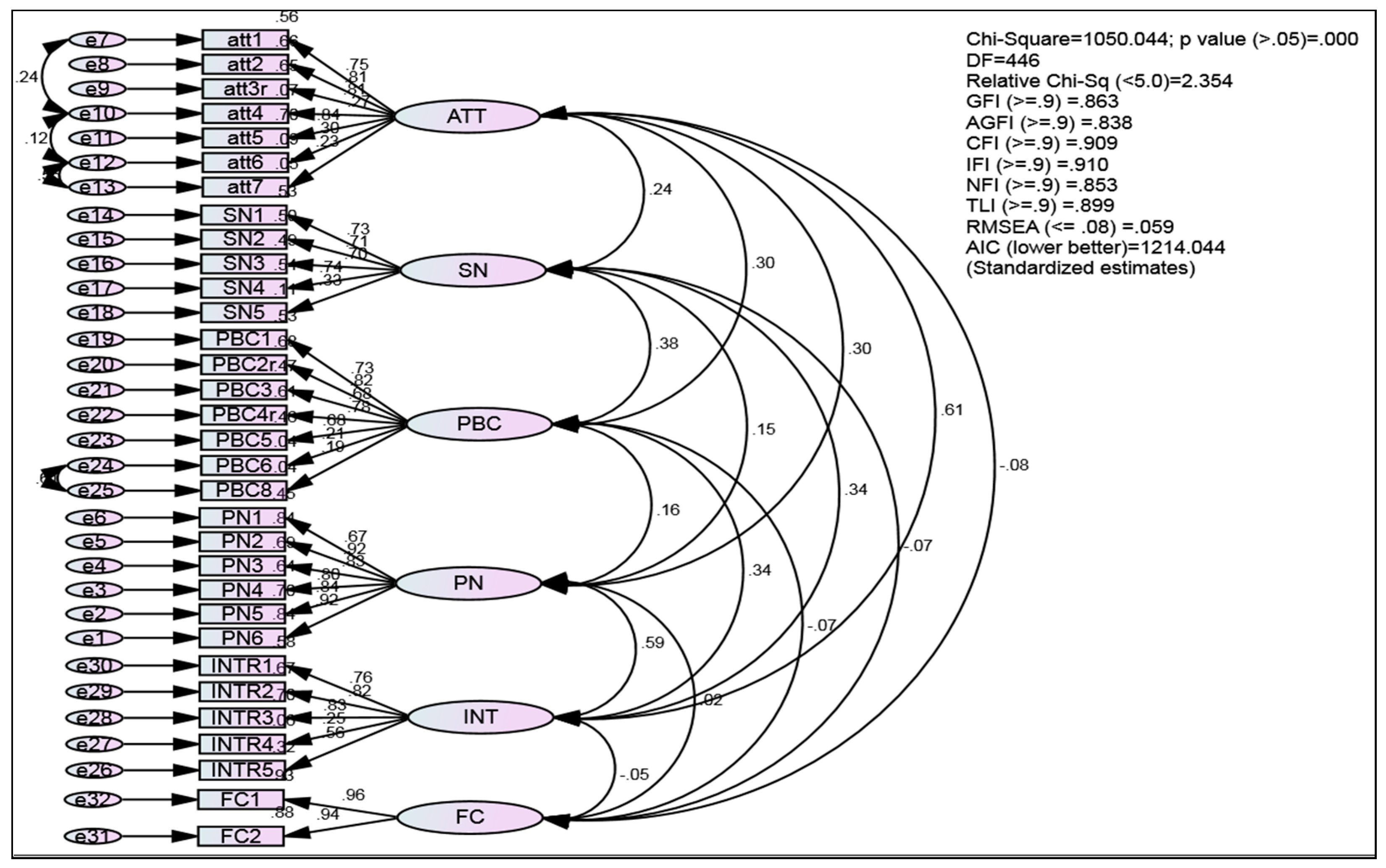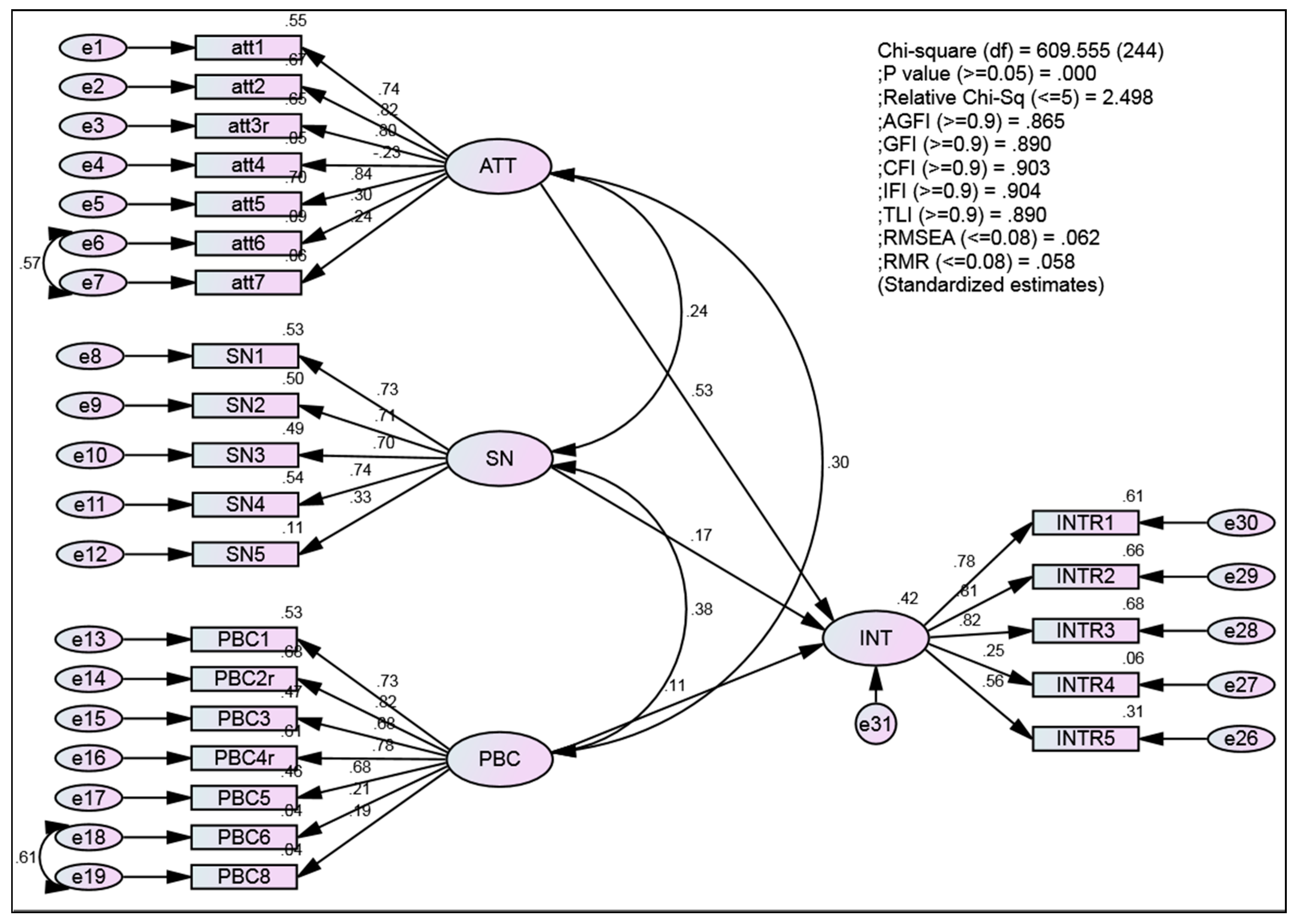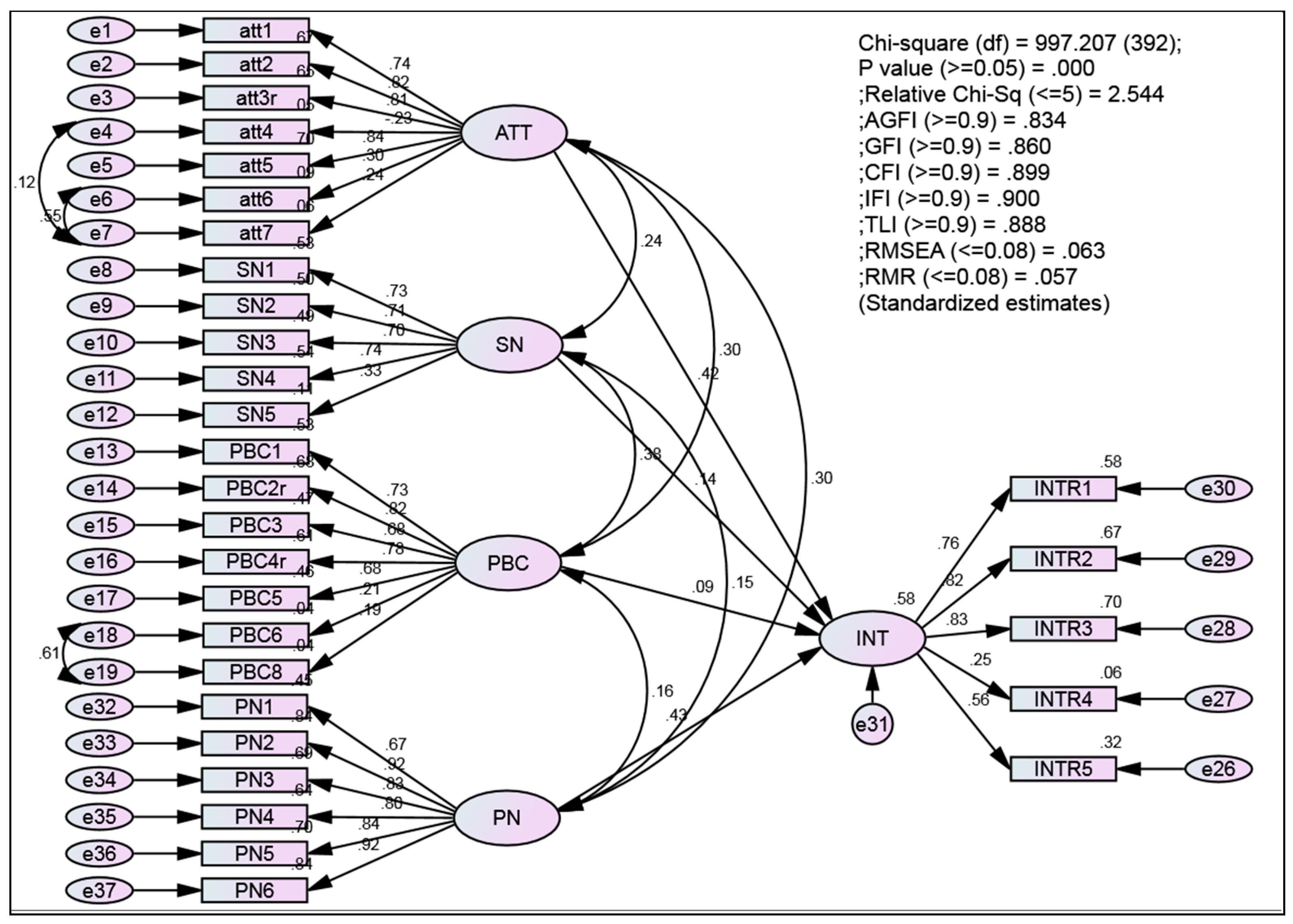1. Introduction
Globally, municipal solid waste management (MSWM) is becoming more complex and difficult to manage, especially in developing countries. Its complexity is as a result of high population growth, rapid urbanization, rising living standard, and change in consumption patterns [
1]. Household solid waste (HSW) refers to the garbage produced as a result of day-to-day activities of the household [
2] and is the major source of MSW in many countries to which most cost of MSWM is allocated [
3]. Additionally, HSW is one of the major issues facing cities in developing countries [
4] such as Nigeria.
In Nigeria, households’ attitude towards waste handling has been a key concern, which leads to many health and environmental problems [
5]. Furthermore, reckless dumping of waste into the drainages and, on any available land has resulted in problems such as environmental degradation, flooding, air and water pollution, etc. Conspicuously, solid waste is seen in most parts of the cities; on the roads, within the neighborhoods and around residential buildings [
6]. Even the solid wastes collected by the municipal authority often end up deposited in the landfills. Landfilling is the major approach adopted for waste disposal in Nigeria; however, it imposes a great danger to the physical environment, underground water, and also leads to scarcity of the land resource [
7]. Effective management of wastes can facilitate recovery of recyclable materials and reduction of its negative environmental impact [
8]. Recycling represents a sustainable way of processing and reusing materials that have been previously used. It also reduces the amount of wastes directly sent to the landfills [
9].
Waste recycling has been widely adopted in developed countries such as Japan, U.K., and the U.S.A., etc. For example, in the U.S.A. recycling laws have been in place since the year 1993, which required people to recycle certain percentage of their waste. A report by the U.S. Environmental Protection Agency [
10] has revealed that the recycling law was successfully implemented, with about 34% of MSW been recycled as of 2010. Similarly, the UK has recorded success in recycling, with about 44.9% of the solid waste generated being recycled as of 2014, and set out to achieve a target of minimum of 50% of recycling rates by the year 2020 [
11]. Additionally, in Japan, the government imposed a strict recycling law that mandated people to minimize waste generation as well as participate in recycling. The law emphasized that all food producers must use recyclable packaging materials for their product, and also encourage their customers to reuse the food packages [
12].
In contrast, recycling activities in Nigeria are mainly carried out by the informal sector [
6] who support themselves by selling recyclable items as secondary materials to local markets, either for local use or export. Even in some cities where the formal waste recycling was introduced, the effect of the program is always limited, and open dumping and landfilling remain the methods most widely practiced. The possible explanation for this is that the existing recycling policies were not targeted toward changing household waste handling behavior. It is evident that policies that are designed to reduce household waste generation and encourage recycling are unlikely to be effective if they are not targeted to the fundamental psychological factors that underpin residents’ motivations to recycle [
13]. Additionally, designing an effective policy intervention, which has a significant effect on factors such as attitude, subjective norms, and perceived behavioral control, can influence individual’s intention to perform a behavior [
14]. Effective recycling policies can influence people’s intention and behavior in different ways; directly through imposing taxes and levy, or generally by changing the social context of people’s behavior [
15], this has been a challenge to the Nigerian MSWM system. For example, previous policies and researches on solid waste management were focused on top-down approach such as institutional problems [
16], provision of infrastructure [
17], appraisal of waste management strategies [
18], regulations and governance [
19], state of the environment [
20], and ignored the bottom-up approach that ensures individual’s participation.
Therefore, this paper leans towards the bottom-up approach to MSWM by investigating household recycling intention in Nigeria. The paper utilizes the theory of planned behavior [
21] to perform this task. The theory has been widely utilized by previous studies to investigate pro-environmental behavior [
22,
23,
24,
25,
26], however, to the best of our knowledge, there is lack of studies that utilized TPB in African continent, particularly in Nigeria. This study is the first that used the TPB to investigate household recycling intention in Nigeria. Furthermore, the present study expands the TPB by including two additional variables: personal norms and perceived lack of facilitating conditions (lack of facilities and local collection) to determine if lack of facilities and local collections affect households intention to recycle. Therefore, the following questions would be addressed in this paper: Does the Theory of Planned Behavior predict recycling intention among households in Kano metropolis Nigeria? What is the role of personal norms in conjunction with TPB components in predicting recycling intention among households in Kano metropolis Nigeria? What is the moderating role of perceived lack of facilitating conditions on households’ recycling intention?
5. Discussion and Policy Implication
The theory of planned behavior (TPB) laid the theoretical foundation of this study. Model 1 explains 42% variance in recycling intention. According to Armitage and Conner [
35], TPB components averagely account for 39% of the variance in intentions. However, Perugini and Bagozzi [
77] reported that 32% variance can be considered adequate. Based on this, we conclude that our model reveals a satisfactory result. Our model can be compared with those of previous studies conducted in the U.S.A. [
78], U.K. [
23], Hong Kong [
79], Iran [
3], Cuba [
80], and Malaysia [
26] indicating robustness of TPB in predicting household recycling behavior despite the differences in availability of facilities between developed and developing countries.
The result of model 1, which includes the TPB constructs (ATT, SN, and PBC), reveals that, although all the TPB components significantly predict households’ recycling intention, attitude appeared as the most important predictor of recycling intention. This means that households’ intention to recycle is influenced primarily by their attitude toward recycling, and to some extent by the pressure and expectation of people around them, and their perceived control over recycling. Consistent with our findings, Tonglet, et al., [
39] reported that attitude was the most important predictor of recycling intention, while perceived behavioural control was not a significant predictor of recycling intention among households in UK. The authors reported availability of recycling facilities, high level of experience and knowledge among their respondents as the main determinants of RI. Therefore, they proposed that for households who had low recycling abilities, PBC would be a significant predictor of their RI. Contrarily, in spite of the fact that attitude is the most significant predictor of recycling intention in our study, in Kano metropolis, recycling facilities are not readily available and majority of the recyclers are doing so for financial benefit rather than environmental concern. This corroborated the findings of Knussen et al., [
33], who asserted that in an area with relatively poor recycling facilities, both attitude and PBC tend to be significant predictors of recycling intention. However, a study by Karim Ghani et al., [
81], which investigated intention to separate food waste at source among households living in an area with poor facilities revealed that attitude was the only predictor of intention, while other variables such as SN, PBC, and situational factors were not significant predictors of intention. In contrast, Ramayah, et al., [
26] reported that attitude and subjective norm were significant predictors of recycling behaviour, while PBC was insignificant predictor in an area with poor waste management facilities in Malaysia. Therefore, it can be concluded that there is no general consensus about which of the TPB construct is the major predictor of waste recycling intention. The findings differ from one area to another and from one study to another.
Although the TPB model has been widely applied in investigating various pro-environmental behaviour and was found valid in most of the studies [
22,
24,
36], inconsistent results were reported regarding which of the TPB variable is the major predictor of recycling intention. The major reasons for the inconsistencies were due to the differences in the availability and conditions of recycling facilities as reported by Karim Ghani et al., [
81], Knussen et al., [
33], and Ramayah, et al., [
26], especially between developed and developing countries. However, this does not affect the validity and reliability of the recycling intention model. Therefore, policy approach should be country specific with due consideration to the availability and accessibility of facilities from one country to another and even across locations within a country.
As for the model 2, our findings corroborated other studies who reported that incorporating additional variables into the TPB framework improves its predictive power for explaining households’ recycling intention (e.g., [
82]). Attitude, SN, and PNs made significant contributions to the variance of recycling intention, but PBC did not. The Model explains 58% of the variance in households’ recycling intention. Consistent with the findings of Miafodzyeva and Brandt, [
43] and Pakpour et al., [
3] our findings reveal that PNs have the higher regression coefficient than the TPB components, thus it is the strongest predictor of recycling intention. This has supported the assertion by previous studies that incorporating PNs in the original TPB framework increases the predictive ability of the model [
3,
22,
43,
46,
47,
82].
Additionally, the inclusion of PNs into the TPB model has taken over the predictive power of the PBC, and also become the most important predictor of recycling intention more than attitude. This finding is consistent with the study of Wan et al., [
83]. This implies that although majority of the respondents engage in informal recycling activities in order to get some financial benefit, they still believed that not recycling is against their norms and recycling is a socially desirable practice. The result also posits that if an individual has a more positive attitude, subjective norms, and hold personal norms towards recycling, he/she may likely have the intention to recycle household waste. On the other hand, people’s perceived control over recycling may not increase their intention to recycle waste if facilities and local collections are not provided.
The failure of the perceived behavioral control to make a significant contribution to recycling intention was not unexpected because, it has been reported in previous studies as a weak contributor to intentions among the TPB components [
24,
36,
83]. When the perceived control is low, the intention to participate in a pro-environmental behavior tends to be low [
84]. For this study, a possible explanation is that a recycling program was not formerly established in Kano metropolis, and facilities for recycling were not readily available in the study area. This can affect the households’ perceived control, which may consequently lower their intention to participate. Poor waste management, particularly recycling facilities, could result in low participation rates of households in waste separation and recycling. In order to improve households’ perceived behavioral control, policies which promote individuals’ ability to recycle would be important in influencing households recycling intention. Such strategies will be particularly important in Kano metropolis where households’ intention to recycle is affected by lack of recycling facilities.
Additionally, the test for moderating effect shows that two of the four paths (attitude—intention, and personal norms—intention) were moderated by perceived lack of facilitating conditions (lack of facilities and local collections). However, the relationships between subjective norms—recycling intention, and perceived behavioral control-recycling intention were not affected by the lack of recycling facilities and local collection. A possible explanation is that households that have more subjective norms and behavioral control over recycling will still have the intention to recycle, even if they perceived a lack of facilitating conditions. On the other hand, when an individual perceives a lack of recycling facilities and local collections, the positive correlations between their attitude—recycling intention, and personal norms—recycling intention will diminish. That is to say, positive attitude and PNs failed to influence recycling intention when local collections and recycling facilities were perceived to be lacking. This result is consistent with that of [
33] who reported that people may not recycle if there are no recycling facilities that would ease their participation, even if they feel recycling is a good thing to do. Also, some of the respondents reported that they fail to recycle because the facilities and local collections are not readily available.
Based on the findings of this research, there are several policy implications regarding the development and implementation of recycling schemes in Kano metropolis Nigeria. First, the findings show that household intention to recycle is influenced by positive attitude, subjective norms, and personal norms. Therefore, the Nigerian government should come up with a recycling awareness campaign to enlighten people about the benefit of recycling to oneself and to the environment. This will help to strengthen people that already have a positive attitude as well as change others with a less positive attitude toward recycling. Some of the issues that should be highlighted in the recycling campaign should include the health and environmental consequences of a poor attitude of households towards waste handling. Also, emphasis should be given to personal gain; especially the financial benefit associated with participating in recycling through selling recyclables items. On the other hand, the government should enlighten and convince people that the benefit of recycling is not only to the environment and themselves, but also it is an altruistic behavior done to benefit others. Therefore, the government should come up with policies that will strengthen households’ intrinsic and moral motivation for recycling. This will enhance household personal norms and positive attitude towards recycling, and ultimately will influence their intention to recycle.
Additionally, the Nigerian government should design a recycling program and include the concept of environmental protection and recycling in primary and secondary school curricula. By doing so, the younger generation will be used as the agent of change at home, community level, and society at large. This strategy will improve personal norms among residents in Nigeria. Also, households should be educated on what, how, why and where to recycle their waste. Only then can the recycling policies and programs be successful.

